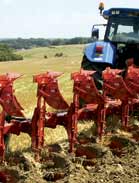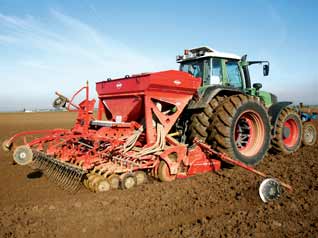Swing back to ploughing?

Robust plough sales suggest some growers may be having second thoughts about surface cultivation techniques, says Andy Collings
According to the Agricultural Engineers Association, sales of ploughs rose by nearly a third in 2008. They were up by 15% in the first half of this year, too, at a time when sales of other machinery are on the decline.
Hand-in-hand with these increases has come a steady rise in purchases of power harrow/drill combinations. This confirms what many had suspected, that a swing back to more conventional plough-and-cultivate crop establishment systems is going on.
This view is supported by Robert Balfour, who farms at Balbirnie Home Farms near Glenrothes in Fife. He has just invested in a new Lemken seven-furrow plough and a 5m power harrow/drill.
“The farm runs to about 3000 acres of which 2000 acres are in combinable crops,” he says. “The other 1000 or so acres are used by our 220-cow suckler cows and their calves.”
 |
|---|
| Output from the 3m Kuhn Venta NC 3000 combination drill is about 20ha/day (50 acres) reports Clive Forster. |
But last year’s bad weather highlighted the inadequacies of a system which required ploughed land to be worked down before a cultivator drill was used to plant the crops.
“On many occasions, the land was simply too wet for the drill to operate,” says Mr Balfour. “Despite efforts to cultivate only a field or two in front of the drill, ground that had been worked down became impassable with the result that we failed to achieve the winter-sown acreage we had planned for – and why we have nearly 800 acres of spring barley this year.”
With a soil type which is, in the main, reasonably easily worked, there has been a temptation in the past to use min-till establishment systems. But this has been largely resisted with such a system now limited to the establishment of the oilseed rape.
The arrival of the 5m Lemken Zirkon Solitaire power harrow drill combination is designed to ensure that the autumn workload is completed irrespective of the weather.
“We’ve used the combination to plant the spring crops, operating it behind a 240hp Fendt 924 Vario and it has worked well, managing about 50 acres a day,” he says. “We’ve now taken delivery of a 300hp Fendt 930 which I expect to boost output to nearer 80 acres a day, which is where we need to be.”
A front hopper is used for combined seed and fertiliser drilling of spring-sown crops, and also helps to balance the weight of the rear mounted drill. In the autumn, the hopper will be used as an extra seed hopper.
“The whole point is that modern power harrow/drill combinations are not the snail-paced, fuel sapping implements they used to be,” insists Mr Balfour. “Their modern design and generous working widths mean that outputs are on par with other cultivation systems – and they can often operate in conditions that keep other systems in the barn.”
Last autumn’s wet conditions were also revealing times for Borders farmer Clive Forster, who says he is convinced he would not have completed his sowing if he had not ploughed and used a power harrow/drill combination.
A strong supporter of the plough, not only as a means of cultivation, but also as a way of keeping on top of grassweed problems, Mr Forster says his arable area extends to about 320ha (800 acres).
Cropping comprises autumn sown wheat, barley, oats and oilseed rape. The land, which ranges from medium to heavy, is ploughed using a five-furrow Kverneland plough pulled by his New Holland T6070.
“I bought a 3m Kuhn Venta NC 3000 combination drill last year and I think it was a timely purchase bearing in mind the conditions we used it in last autumn,” he says.
This pneumatic disc coulter drill combination has a power harrow and press unit along with a 2000-litre seed hopper. Keeping the New Holland’s front wheels on the ground means that a front-mounted 3m He-Va press is required.
“Output, far from being a few acres a day can be as much as 50 acres and I have to report that my fuel costs have not increased,” he insists. “There does seem to be a move away from min-till in this area with increasing use of ploughs – and if you use a plough, a power harrow/drill combination has to be the obvious choice.”

